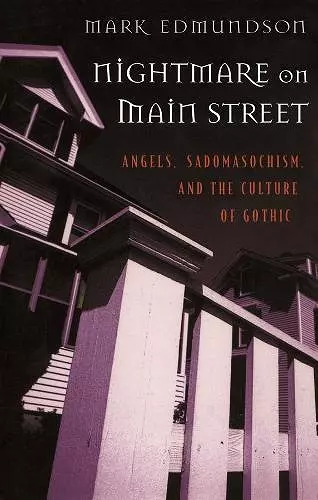Nightmare on Main Street
Angels, Sadomasochism, and the Culture of Gothic
Format:Paperback
Publisher:Harvard University Press
Published:1st Dec '99
Currently unavailable, and unfortunately no date known when it will be back

Once we've terrified ourselves reading Anne Rice or Stephen King, watching Halloween or following the O. J. Simpson trial, we can rely on the comfort of our inner child or Robert Bly's bongos, an angel, or even a crystal. In a brilliant assessment of American culture on the eve of the millennium, Mark Edmundson asks why we're determined to be haunted, courting the Gothic at every turn--and, at the same time, committed to escape through any new scheme for ready-made transcendence.
Nightmare on Main Street depicts a culture suffused with the Gothic, not just in novels and films but even in the nonfictive realms of politics and academic theories, TV news and talk shows, various therapies, and discourses on AIDS and the environment. Gothic's first wave, in the 1790s, reflected the truly terrifying events unfolding in revolutionary France. What, Edmundson asks, does the ascendancy of the Gothic in the 1990s tell us about our own day?
And what of another trend, seemingly unrelated--the widespread belief that re-creating oneself is as easy as making a wish? Looking at the world according to Forrest Gump, Edmundson shows how this parallel culture actually works reciprocally with the Gothic.
An unchecked fixation on the Gothic, Edmundson argues, would result in a culture of sadomasochism. Against such a rancorous and dispiriting possibility, he draws on the work of Nietzsche and Shelley, and on the recent creations of Toni Morrison and Tony Kushner, to show how the Gothic and the visionary can come together in persuasive and renovating ways.
[A] compelling explanation of our ever more ghoulish obsessions. -- Jeffrey Toobin * The New Yorker *
One cannot but admire the forward pressure of the argument, the breadth of reference, the passion with which it is conducted, and, at times, the passages of analysis. -- Francis Devlin-Glass * Canadian Review of Literature *
In his provocative book about the Gothic, Mr. Edmundson notes that the genre flourished in the years after the French Revolution. Those drafty castles with their dark secrets, the vampirish counts and the leering clergymen were all embodiments of the ancient regime, the old feudal order haunting the unsteady world of the new. Modern innocents are lured into that realm and nearly overwhelmed by it, until they exorcise its demonic control. The past is finally passed. The disgusting is contained, controlled, overcome. But today, Mr. Edmundson argues there is no clear resolution to our Gothic tales. Their haunting addictions and demonic figures keep reappearing in rock videos, computer games, television talk shows and horror films. But the villainy is ambiguous...No sooner do we start to hate the wife abuser on a talk show than we learn that he too is a haunted victim of abuse or a recovering addict. We are all villains and all victims. -- Edward Rothstein * New York Times *
Absorbing...The Gothic thrives, Edmundson argues, in a world in which 'those in authority--the supposed exemplars of the good--are under suspicion,' a world in which cynicism ('the conviction that the worst truth that you can come up with about any person or event is the most consequential truth') is a given...Drawing upon his considerable knowledge of American and European literature, Edmundson does a nimble job of situating the current Gothic craze in context with philosophical developments, while at the same time assessing its social consequences...Nightmare on Main Street is a provocative and often illuminating book. -- Michiko Kakutani * New York Times *
Edmundson's book has a simple yet visionary thesis. America--the patient--is infected with a psychological virus that fosters a death-worshipping attitude toward existence...Edmundson's clarity of vision, airtight logic, and captivating prose...succeed in convincing the reader of his thesis...[He] is strongly conversant with classic Anglo-American literature, movies and television. Part of this book's intellectual charm is that he draws on such a heterogeneous range of supporting examples, from Oprah to Hitchcock, from Wordsworth to Robert Bly, from Wes Craven to Keats. -- Paul Di Fillippo * Washington Post Book World *
I never would have thought that Forrest Gump, Sigmund Freud and O.J. Simpson had anything to do with one another. But Mark Edmundson turns them into one big, dysfunctional family in his provocative new book about contemporary American culture...The strength of Edmundson's analysis is his ability to use the concept of the gothic sensibility to tie together seemingly disparate strands of contemporary culture and show how our view of reality is shaped by them...I suggest Nightmare on Main Street to readers who want to understand the stories America tells itself. -- Greg Beatty * News & Observer *
ISBN: 9780674624634
Dimensions: unknown
Weight: 240g
208 pages